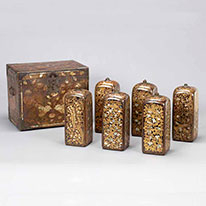Past Exhibitions
- Glocal Makie Lacquers from Early Modern Japan
- February 2, 2021 - February 28, 2021
Maintaining a global perspective while respecting local variations is a tenet of modern marketing; however, glocal perspectives were already being put into practice during the Age of Discovery, as evidenced by the international trade in lacquerware. Lacquer is a resin made from the toxic sap of the lacquer tree (Rhus verniciflua), native to East Asia. When it hardens, it forms a durable coating resistant even to acid and alcohol. Early Westerners were surprised to learn that lacquer is impervious to boiling water. When decorated with the uniquely Japanese technique of makie, using sprinkled gold and other metallic powders, lacquerware became a popular trade commodity exported not only to Europe but also to China and the Americas. Such items often show the influence of Indian mother-of-pearl inlay and sometimes incorporate ray skin imported from Thailand.












